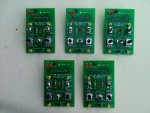Sigurthr
0
- Joined
- Dec 11, 2011
- Messages
- 4,364
- Points
- 83
Hello photon fanatics!
I recently purchased a very nice cyllindrical argon ion laser head and matching psu from Daguin during one of his massive clean outs. I've been wanting one of these lasers since I was a kid and first saw a single line 488 that I think did a whopping 10mW at some insane power input level. Finally I have a beautiful one of my own, and it is a killer 80mW max multiline as well! I have been able to get SEVEN lines out of this amazing machine.
The unit did not come with a remote, but Dave included a DB25 headder jumpered to idle. Links to a schematic for a remote on RepairFAQ.org were posted for me and I ordered parts and drew up a schematic. I finally test the remote design and it did not work! I first contacted Dave, then later Sam at RepairFAQ, but no one knew why exactly. I did some probing, experimenting, and digging around and discovered that the pins listed as "ground" pins were not actually ground pins at all! Some were negative voltage rails as low as -30V!
So, I found a scanned version of the manual for this series power supply which lo and behold stated that only Pin 11 was to be used for the return paths (i.e. ground) for the various functions. A not so quickly installed mass of jumpers on Dave's headder and it worked! Okay, time to redraw the schematic and get building. I spent about three and a half hours building the remote, but I did not want to take any short cuts and chance another failure or error.
I'm still having issues with "Discharge Enable" and the Interlock system not turning off power to the laser tube when they are supposed to. It appears that Discharge being put to disable while the laser is in Run mode and above a certain current threshold will actually turn off the laser tube current, but I haven't tested it much. I wrote Sam another email informing him of progress, he might have some more info as well. I am trying to avoid opening the power supply at all costs.
Here are the results:






More Pics and Videos to come!
I recently purchased a very nice cyllindrical argon ion laser head and matching psu from Daguin during one of his massive clean outs. I've been wanting one of these lasers since I was a kid and first saw a single line 488 that I think did a whopping 10mW at some insane power input level. Finally I have a beautiful one of my own, and it is a killer 80mW max multiline as well! I have been able to get SEVEN lines out of this amazing machine.
The unit did not come with a remote, but Dave included a DB25 headder jumpered to idle. Links to a schematic for a remote on RepairFAQ.org were posted for me and I ordered parts and drew up a schematic. I finally test the remote design and it did not work! I first contacted Dave, then later Sam at RepairFAQ, but no one knew why exactly. I did some probing, experimenting, and digging around and discovered that the pins listed as "ground" pins were not actually ground pins at all! Some were negative voltage rails as low as -30V!
So, I found a scanned version of the manual for this series power supply which lo and behold stated that only Pin 11 was to be used for the return paths (i.e. ground) for the various functions. A not so quickly installed mass of jumpers on Dave's headder and it worked! Okay, time to redraw the schematic and get building. I spent about three and a half hours building the remote, but I did not want to take any short cuts and chance another failure or error.
I'm still having issues with "Discharge Enable" and the Interlock system not turning off power to the laser tube when they are supposed to. It appears that Discharge being put to disable while the laser is in Run mode and above a certain current threshold will actually turn off the laser tube current, but I haven't tested it much. I wrote Sam another email informing him of progress, he might have some more info as well. I am trying to avoid opening the power supply at all costs.
Here are the results:






More Pics and Videos to come!
Last edited:







